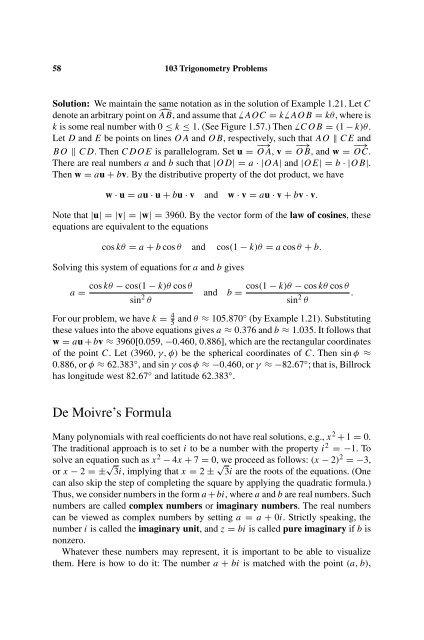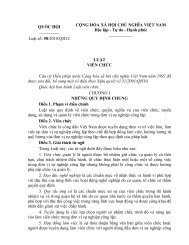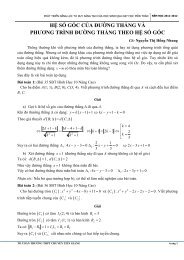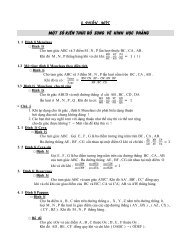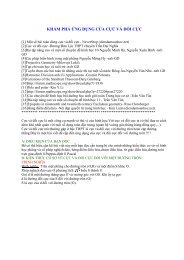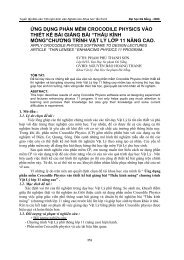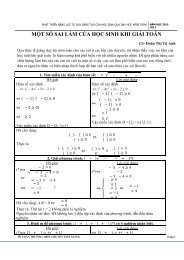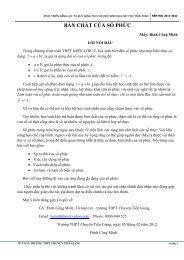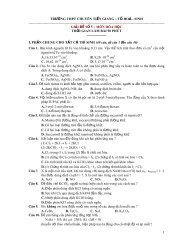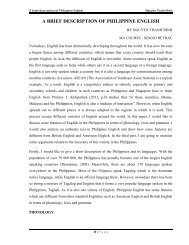103 Trigonometry Problems
103 Trigonometry Problems
103 Trigonometry Problems
Create successful ePaper yourself
Turn your PDF publications into a flip-book with our unique Google optimized e-Paper software.
58 <strong>103</strong> <strong>Trigonometry</strong> <strong>Problems</strong><br />
Solution: We maintain the same notation as in the solution of Example 1.21. Let C<br />
denote an arbitrary point on ÂB, and assume that ̸ AOC = k̸ AOB = kθ, where is<br />
k is some real number with 0 ≤ k ≤ 1. (See Figure 1.57.) Then ̸ COB = (1 − k)θ.<br />
Let D and E be points on lines OA and OB, respectively, such that AO ‖ CE and<br />
BO ‖ CD. Then CDOE is parallelogram. Set u = −→ OA, v = −→ OB, and w = −→ OC.<br />
There are real numbers a and b such that |OD|=a ·|OA| and |OE|=b ·|OB|.<br />
Then w = au + bv. By the distributive property of the dot product, we have<br />
w · u = au · u + bu · v and w · v = au · v + bv · v.<br />
Note that |u| =|v| =|w| =3960. By the vector form of the law of cosines, these<br />
equations are equivalent to the equations<br />
cos kθ = a + b cos θ and cos(1 − k)θ = a cos θ + b.<br />
Solving this system of equations for a and b gives<br />
cos kθ − cos(1 − k)θ cos θ<br />
a =<br />
sin 2 θ<br />
and<br />
cos(1 − k)θ − cos kθ cos θ<br />
b =<br />
sin 2 .<br />
θ<br />
For our problem, we have k = 4 5 and θ ≈ 105.870◦ (by Example 1.21). Substituting<br />
these values into the above equations gives a ≈ 0.376 and b ≈ 1.035. It follows that<br />
w = au + bv ≈ 3960[0.059, −0.460, 0.886], which are the rectangular coordinates<br />
of the point C. Let (3960,γ,φ) be the spherical coordinates of C. Then sin φ ≈<br />
0.886, or φ ≈ 62.383 ◦ , and sin γ cos φ ≈−0.460, or γ ≈−82.67 ◦ ; that is, Billrock<br />
has longitude west 82.67 ◦ and latitude 62.383 ◦ .<br />
De Moivre’s Formula<br />
Many polynomials with real coefficients do not have real solutions, e.g., x 2 + 1 = 0.<br />
The traditional approach is to set i to be a number with the property i 2 =−1. To<br />
solve an equation such as x 2 − 4x + 7 = 0, we proceed as follows: (x − 2) 2 =−3,<br />
or x − 2 =± √ 3i, implying that x = 2 ± √ 3i are the roots of the equations. (One<br />
can also skip the step of completing the square by applying the quadratic formula.)<br />
Thus, we consider numbers in the form a +bi, where a and b are real numbers. Such<br />
numbers are called complex numbers or imaginary numbers. The real numbers<br />
can be viewed as complex numbers by setting a = a + 0i. Strictly speaking, the<br />
number i is called the imaginary unit, and z = bi is called pure imaginary if b is<br />
nonzero.<br />
Whatever these numbers may represent, it is important to be able to visualize<br />
them. Here is how to do it: The number a + bi is matched with the point (a, b),


